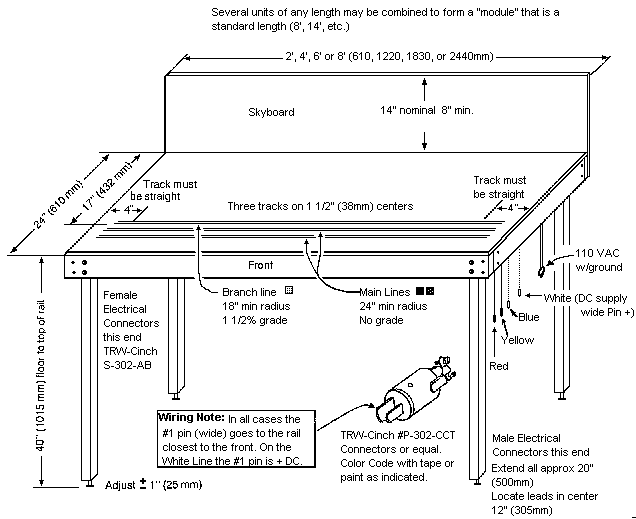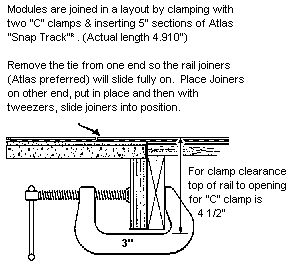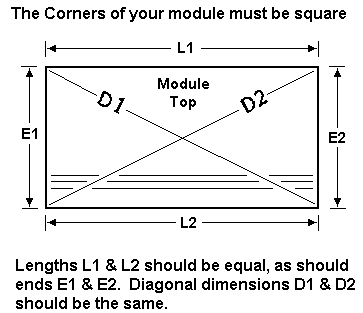These Standards and Recommended Practices (RPs) have been assembled from data sent in from module groups that are actively building and operating these units in all parts of the country. It is clearly indicated that there are two distinct types of operation desired so we have set up two separate sets of figures in order to accommodate both groups.
A module is a portable section of table type structure which is but one part of a large group of like tables which when all assembled together form a large and fully operating model railroad. They are built by individuals as part of a home layout or specifically for use interfacing with others in a large setup. All are built to a set of standards that allow each unit to interface exactly with other units anywhere in the overall system. A module may be a single table or a group of tables which must be capable of interface at each end but may deviate between these ends so long as the type of operation is not compromised or restricted. By being portable, they may be disassembled for transporting to conventions or public displays. Many clubs are formed for the specific purpose of building module layouts as space for a permanent layout is hard to find and is very expensive when available.
A sectional layout is built in a similar manner but each unit is constructed to fit in a specific spot in the overall layout and will not fit in any other place. As new units are built, they must be designed to fit in a particular place and will not interface anywhere else. Some sectional layouts may be built to NMRA Standards but most are to a set of figures agreed upon by the group as interface is not a factor to be required.
The two types are required because two distinct areas of operation used in the existing modules. One is for Mainline type operation such as very long freight trains and high speed passengers that require larger radii with no grades which would restrict this type of movement of equipment. The second type of module is called Industrial or Secondary as it is so constructed as to allow certain grades and shorter radii such as is found in branch line and logging or industry areas. This type even allows a complete helix such as the two famous loops in California where the motive power passes over the rear end of it's own train. This requires grades and sharper curves which severely restrict the length and speed of the trains. These two types of modules may meet the interface requirements but are not compatible in operation so should not be used in the same setup.
A transition module is a unit so constructed that it will interface at one end with an existing non-standard unit and interface with an NMRA module at the other. These are necessary when existing modules are used with the new NMRA standard ones in a setup but care must be used that Secondary types are not assembled with Mainline types due to the restrictions stated above.
A Standard is a set of specifications that are mandatory, "cut in stone" so to speak and must be followed to facilitate interchange or interface, whichever the case may be. These can be changed from time to time but ONLY after they have been posted on this website for NMRA membership comment and after proper policy procedures have been followed. Recommended Practices (RPs) are those practices that the Standards Department has established through actual tests and feel are beneficial to operation. Standards and Recommended Practices are presented to the Board of Directors (BOD) for their study and approval.
A Data Sheet is a listing of helpful information which supplements the Standards and RPs. They often contain drawings or sketches as an aid to construction. These are not put to a vote and are not documents of the Standards Department, they are maintained by the Education Department. Any technical information presented in the Data Sheets affecting the operation of the railroad are reviewed by the Standards Department for accuracy.
Within the NMRA there are many Special Interest Groups (SIG). Among them are modular groups for each scale and they have much to offer the builder in the way of data and information. These groups are listed from time to time in the NMRA Magazine. It is suggested that the newcomer to module building study the Standards, RPs, and Data Sheets of both NMRA and the SIG. Before starting it would be useful to attend a meet where modules are set up and operating and discuss the pros and cons of both module types and then decide which type best suits your goals. Good preparation will reduce the number of problems when interfacing your module with others for the first time. There are often small adjustments to be made but if care is taken and proper planning is done, these can be kept to a minor nature.
We are most grateful to NTRAK for the courtesy of using some of their drawings which have evolved from more than 15 years of successful construction and operation. The basic methods of construction are applicable to the other scales. Only the dimensions need be changed. In the case of 0 scale, 1" x 6" side panels are suggested due to the increased weight of the models which will be used in the operation. Data Sheets will show how other groups differed in some of the construction details so it is advisable to study all available material, choosing those most suitable to your own particular needs or desires. Scales larger than 0 should use suitable larger side panels according to the weight they are expected to carry. The engineering committee is always ready to help those in need, with suggestions as to the way to approach a problem area.
Below is a drawing of a typical module as used by NTRAK. It may be used for any scale. For the larger scales it may be advisable to use larger size pieces of wood due to the possible heavier models which will be run on it.
Electrical Standards may differ with each scale. Check the SIG, of your scale.
Shown below are the basic specifications for standard NTRAK modules. These are the minimum requirements for all modules. Optional tracks, construction methods and module sizes are given on other pages.



These drawings are Courtesy of NTRAK. Dimensions shown are for N scale.